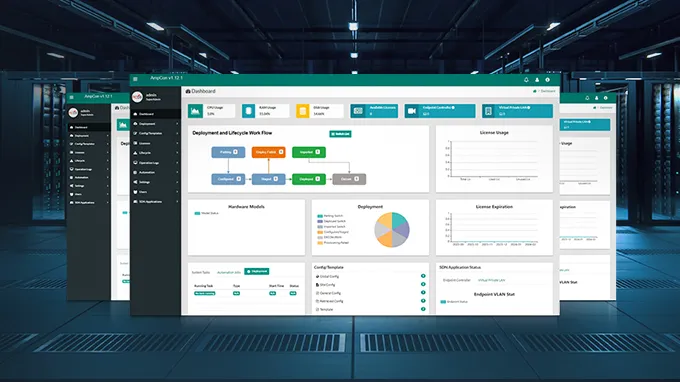Choose POTN to Efficiently Improve Your Network Performance
In recent years, an operator’s paradox has become increasingly apparent: despite a substantial annual increase in data traffic volumes ranging from 45-65%, revenue growth remains minimal, often in the single digits. To address this disconnect, providers must assess network architecture enhancements aimed at reducing transport costs per bit, conserving space and power, and enhancing network performance to minimize operational expenses (OPEX). POTN technology, which combines the technical advantages of PTN and OTN, has emerged as a solution meeting diverse market demands and networking application scenarios. Let's delve into the definition, key factors, and benefits of POTN to gain a deeper understanding.
What Is POTN?
Packet Optical Transport Network (POTN) is a transport network that deeply integrates packet transport and optical transport technologies. Packet Transport Network (PTN) refers to an optical transport technology where a layer is set between the IP service and the underlying optical transmission medium for the burstiness and statistical recovery of packet traffic. Optical Transport Network (OTN) implements transmission, multiplexing, routing, and monitoring of service signals in the optical domain, and guarantees performance indicators and survivability.
POTN encompasses a range of technologies and architectures designed to facilitate the transmission of IP packets across both fixed and mobile optical networks. Converged products within this domain integrate various functionalities, including WDM wavelength switching, Ethernet switching utilizing different protocols, and TDM and OTN/ODU switching.
These technologies comprise a blend of optical networking products, which may operate independently or coalesce within a unified platform known as a Packet Optical Transport System (POT-S). Components such as Reconfigurable Optical Add/Drop Multiplexers (ROADMs), TDM equipment, and Carrier Ethernet switching devices form part of these platforms. They are strategically positioned within the metro edge, metro core, and long-haul networks of major service providers to enhance network efficiency and performance.
Key Factors in POTN
ROADM Infrastructure: Implement ROADM infrastructure that supports wavelength routing at multi-degree junctions, including both multi-degree and simpler two-degree nodes.
ROADMs enhance transport network agility by minimizing manual intervention for setting up new lightpaths. Comprising subsystems like Wavelength Selective Switches (WSSs), optical amplifiers, channel monitors, transponders, and control software, ROADMs eliminate expensive optical-to-electrical conversions at intermediate nodes, enabling wavelengths to pass through in the optical domain.
Meanwhile, when implementing POTN, you can choose the high-quality ROADM product in FS. FS ROADM-09T is based on advanced second-generation wavelength-selective switch (WSS) technology to support full colorless, directionless and contentionless (CDC-F) system configuration. This D7000 Series module is a built-in pre-amplifier and booster amplifier which can simplify the installation and scalability of your ROADM network while improving its overall flexibility and performance. ROADM-09T supports N*12.5GHz flexible grid (4≤N≤12). Besides, this module can achieve add-and-drop services or pass-through.
Efficient Support for SONET/SDH Services: Ensure efficient transport of existing SONET/SDH services alongside high-growth packet and OTN traffic, without sacrificing performance or scalability.
Layer 2 Ethernet Switching and Aggregation: Incorporate connection-oriented Layer 2 Ethernet switching and aggregation capabilities to facilitate seamless integration with existing Ethernet networks and support diverse traffic types.
Carrier-Grade OAM Integration: Merge optical and packet domain management functionalities to provide carrier-grade Operations, Administration, and Maintenance (OAM), enabling operators to gain a comprehensive view of the network's health and performance across all layers.
Why Choose POTN?
Packet Optical Transport Network offers a range of benefits that make it an attractive choice for organizations. Here are some key reasons why businesses choose to use POTN:
Convergence
POTN combines the benefits of packet switching and optical transport technologies, providing a converged network infrastructure. It allows for the efficient transport of both traditional circuit-switched traffic and packet-based data over the same network.
Flexibility
POTN offers flexibility in terms of service types. It can support a wide range of services, including voice, data, and video, making it suitable for various applications and customer demands.
Bandwidth Efficiency
With packet switching capabilities, POTN can efficiently utilize network bandwidth by dynamically allocating resources based on demand. This helps optimize network utilization and ensures efficient use of available resources.
Scalability
POTN is highly scalable, enabling network operators to easily expand their network capacity as traffic demands increase. It provides flexibility for adding new services and accommodating future growth without significant disruptions.
Cost-Effectiveness
By leveraging packet switching technology and optical transport, POTN can deliver cost-effective solutions for network operators. It helps reduce operational costs, simplifies network management, and allows for the consolidation of multiple services onto a single network infrastructure.
Conclusion
The adoption of POTN holds numerous advantages for organizations. By embracing POTN, organizations can unlock the true potential of their networks, transform their operations, and propel themselves forward in an era of rapid digital connectivity.
You might be interested in
Email Address

-
PoE vs PoE+ vs PoE++ Switch: How to Choose?
May 30, 2024














